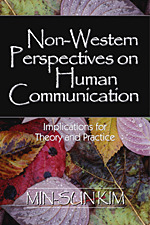I. INTRODUCTION
1. "Who am I?": Cultural Variations in Self-Systems
Evolution of Western Self-Construction: "America's Civil Religion"
Interdependent Self-Construals-An Alternative Framework
2. Independent and Interdependent Models of the Self as Cultural Frame
3. Why Self-Construals are Useful
Parismony of Explanation: Impact of Culture
Cultural Relativity of Communication Theories
ii. CULTURAL RELATIVITY OF COMMINCATION CONSTRUCTS AND THEORIES: "U.S.- CENTRISM"
4. "Communication Apprehension": "Deficiency" or "Politeness"?
Motivation to "Avoid" Verbal Communication
Traditional View: Communication "Avoidance" as a Deficiency
Communication Avoidance Stemming from a Sensitivity to Social Contexts
5. Motivation to "Approach" Verbal Communication: Is Communication Approach Always Healthy?
Assertiveness: "Standing up for your own Rights"
Argumentativeness: A Subset of Assertiveness
6. Conflict Management Styles: Is Avoidance Really a "Lose-Lose"?
Prior Conflict Management Typologies
Individualistic Bias in Past Conceptualizations of Conflict Styles
7. Cognitive Consistency: A Cultural Assumption?
Fundamental Assumptions of Cognitive Dissonance Theory
Is Cognitive Dissonance a Culture-Bound Concept?
8. Attitude-Behavior Consistency: Cultural Ideal of the Individualistic Society
Predicting Behaviors: Deemphasizing Situations Over Attitudes
Emphasizing Other Sources of Behavior
9. Susceptibility to Social Influence: Conformity or "Tact"?
An Eco-Cultural Explanation of Conformity
Conformity as "Social Sensitivity," Independence as "Insensitivity"
10. Internal Control Ideology and Communication: Are Internals "Good Guys" and Externals "Bad Guys"?
Internal Control Ideology
Relationship between Locus of Control and Communication Ideology
11. Deceptive Communication: Moral Choice or Social Necessity?
Deception as a Moral Issue: Independent Perspective
Deception as a Social Necessity: Interdependent Perspective
12. Self-Disclosure: Bragging vs. Negative Self-Disclosure
Motivational Influences on Styles of Self-Disclosure
13. Silence: "Is It Really Golden?"
Silence as Malfunctioning of (Human) Machines
Neglected Component of Human Communication: Silence
14. Acculturative Communication Competence: Who Bears the Burden of Adjustment?
Assimilation Model: "Marginal Man [sic]" Perspective
Alternation Model: Bicultural Perspective
Host Communication Competence: One-Way Assimilation
Bicultural Communication Competence: Alternation Model
III. TOWARDS A BI-DIMENSIONAL MODEL OF CULTURAL IDENTITY
15. The Sources of Dualism: Mechanistic Cartesian Worldview
Bias Toward "Yang" Communication Behaviors
Particle/Wave Paradox: Implications of Personhood for Human Communication
16. Dimensionality of Cultural Identity
Unidimensional Model of Self-Construals
Bi-dimensional Model of Self-Construals
Support for the Bi-dimensional Model
Formation of Bicultural Identity
IV. CONCLUSION-TOWARDS MODELS OF MATURITY
17. Into the Future: Implications for Future Inquiry
Postscript
References








